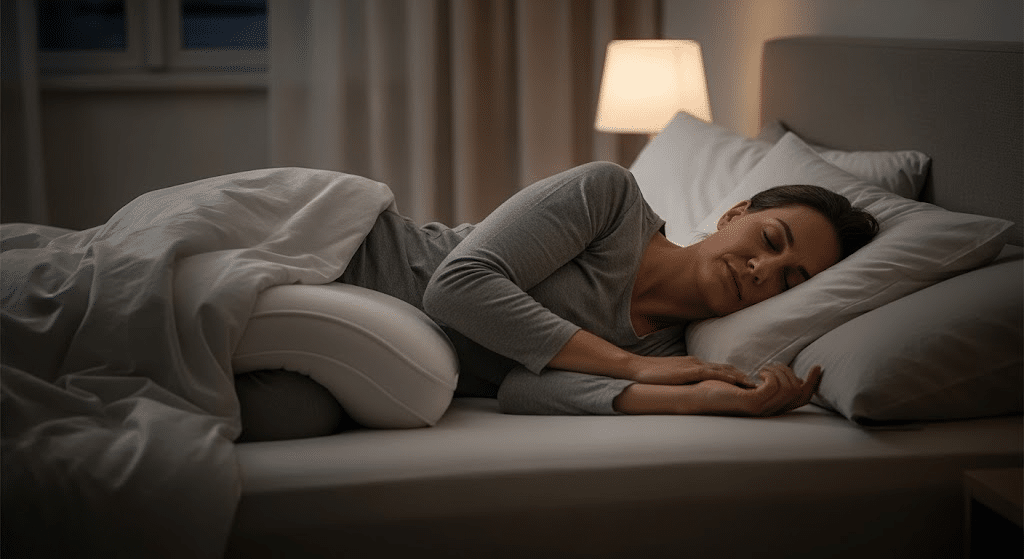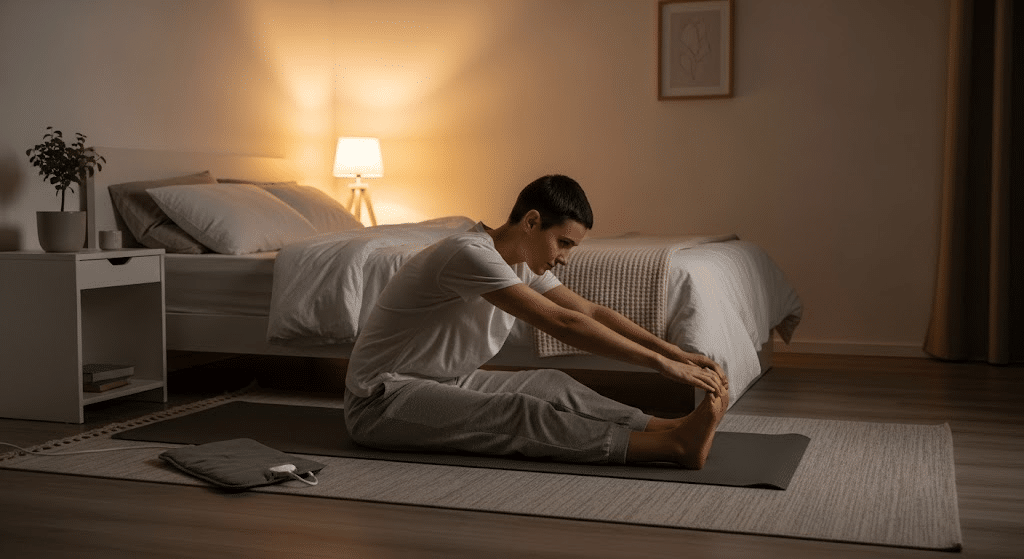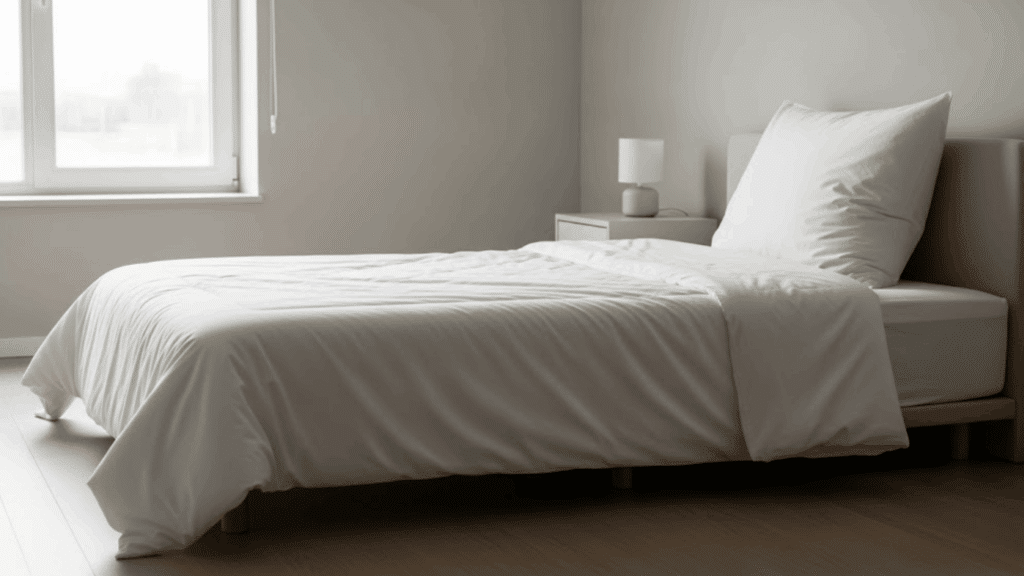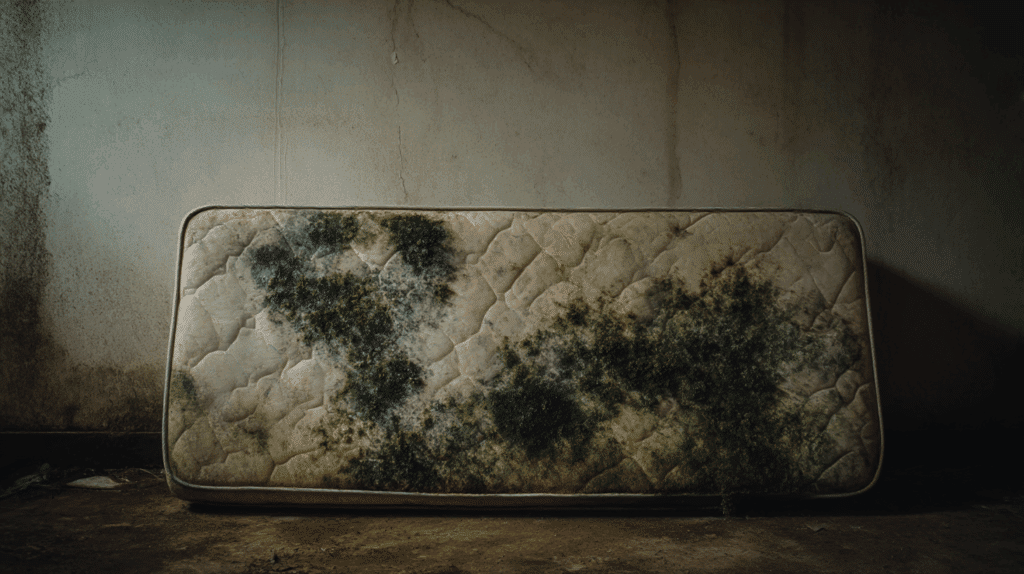Sciatica pain can turn bedtime into a nightmare. That sharp, shooting pain down your leg makes it nearly impossible to get comfortable, leaving you tossing and turning all night.
If you’re wondering how to sleep with sciatica pain, you’re not alone. Millions of people deal with this frustrating condition that seems to get worse right when you need rest the most.
The pain often strikes when you’re trying to relax, making sleep feel impossible.
Simple changes to your sleeping position, mattress setup, and bedtime habits can bring real relief. These practical solutions can help you finally get the restful sleep your body needs to heal and reduce pain naturally.
Understanding Sciatica: Why Nighttime Is So Tough
Sciatica happens when your sciatic nerve gets pinched or irritated. This nerve runs from your lower back down through your hips and legs.
When it’s bothered, you might feel sharp pain, burning, tingling, or numbness that shoots down one leg. Some people also feel weakness in their legs or feet.
Nighttime can be especially hard for people with sciatica. When you lie down, the pressure on your spine changes. Some sleeping positions can make the nerve compression worse. If you sleep on your stomach, it can arch your back too much.
Sleeping on the wrong side might put pressure right on the sore spot. Even a soft mattress that lets your body sink in can keep your spine out of its natural position, making the pain worse throughout the night.
Sleeping Positions for Sciatica Relief
Finding the right sleeping position can make a huge difference in managing sciatica pain. The key is keeping your spine in a neutral position that reduces pressure on the sciatic nerve. Here are the positions that work best for most people with sciatica:
1. On Your Back with a Pillow Under Knees

Sleeping on your back is often the best choice for sciatica pain. Put a pillow under your knees to keep your spine’s natural curve.
This position spreads your weight evenly and takes pressure off your lower back. Your sciatic nerve gets the most relief this way. Make sure your pillow supports your head without pushing it too far forward.
2. On Your Side with a Pillow Between Legs

Side sleeping can work well if you do it right. Place a pillow between your knees to keep your hips lined up. Sleep on the side that doesn’t hurt, if possible.
This keeps your spine straight and reduces twisting. Your top leg should rest on the pillow, not hang down. This position helps many people sleep through the night with less pain.
3. Fetal Position for Herniated Disc Cases

If you have a herniated disc causing your sciatica, the fetal position might help most. Curl up on your side with your knees pulled toward your chest.
This opens up space between your spine bones and can take pressure off the pinched nerve. Don’t curl up too tightly, though. Keep it gentle and comfortable for the best results.
Mattress Matters: Is Yours Helping or Hurting?
Your mattress plays a big role in how well you sleep with sciatica. The wrong mattress can make your pain much worse by letting your spine sag or creating pressure points.
A good mattress should keep your spine straight while you sleep and support your body’s natural curves. Medium-firm mattresses usually work best for sciatica pain.
They’re firm enough to support your spine but soft enough to cushion pressure points. Memory foam and hybrid mattresses both can work well if they provide good support. If your mattress is over eight years old, sags in the middle, or makes you wake up stiff, it might be time for a new one.
When shopping, look for four key things: proper spinal support, good alignment, pressure point relief, and the right firmness level for your body weight and sleeping position.
Nighttime Habits that Ease Sciatica Before Bed

What you do before bed can make a big difference in how well you sleep with sciatica. Start with gentle stretches like knee-to-chest pulls or simple hip stretches to loosen tight muscles.
A warm bath or heating pad for 15-20 minutes can relax your muscles and reduce pain signals. Avoid eating heavy meals or drinking caffeine at least 3 hours before bedtime, as these can keep you awake when you’re already dealing with discomfort.
Try some light meditation or deep breathing exercises to calm your mind and body. Pain can make it hard to relax, but focusing on your breath helps break the cycle of worry about sleep.
Even 5-10 minutes of quiet time can prepare your body for rest and make it easier to fall asleep despite the pain.
What to Avoid: Sleeping Mistakes that Make Sciatica Worse
Certain sleeping habits can make your sciatica pain much worse without you even realizing it. Here are the most common mistakes people make and how to fix them.
| AVOID THIS | DO THIS INSTEAD |
|---|---|
| Too-soft beds that let your body sink in | Medium-firm mattress that supports your spine |
| Poor pillow placement or no pillow support | Strategic pillow placement under knees or between legs |
| Twisting when turning in bed quickly | Roll as one unit – move your whole body together |
| Sudden movements when getting up | Gentle transitions – move slowly and use your arms for support |
Making these simple changes can help you avoid flare-ups and get better sleep. Remember, small adjustments in how you move and position yourself can make a big difference in your pain levels.
Tips to Sleep Better with Sciatica
Getting good sleep with sciatica takes more than just finding the right position. These tips can help you sleep better and wake up with less pain.
- Stick to a Consistent Sleep Schedule – Keeps your body in sync and improves rest quality.
- Use Heat Therapy Before Bed – Loosens tight muscles and reduces nerve tension.
- Heighten Your Legs Slightly – Reduces pressure on the lower back and sciatic nerve.
- Avoid Long Periods of Sitting Before Bed – Sitting aggravates the nerve; take breaks.
- Invest in a Supportive Mattress Topper – An affordable fix if you can’t change your mattress yet.
Try one or two of these tips tonight, then add more as they become habits. Most people see better sleep within a few days of making these small changes.
When to See a Doctor About Sciatica and Sleep Disruption

Sometimes sciatica pain is too serious for home remedies alone. See your doctor if changing your sleeping position and mattress doesn’t help after two weeks.
Also, get medical help if you have numbness in your leg, weakness when walking, or pain that shoots down both legs. Loss of bowel or bladder control needs immediate emergency care.
Your doctor can offer treatments like physical therapy, steroid shots, or imaging tests to find the exact problem. They might suggest MRI scans to see what’s pressing on your nerve.
Remember, you shouldn’t have to live with painful nights forever. Good sleep is important for healing, and there are medical treatments that can help when simple changes aren’t enough.
Summing It Up
Finding ways to sleep better with sciatica pain takes time, but it’s absolutely worth the effort. The key is trying different strategies until you find what works best for your unique situation.
Start with adjusting your pillow placement or switching to a better sleeping position tonight.
Small changes like these can make a surprisingly big difference in how you feel each morning. Remember, quality sleep helps your body heal faster and manage pain more effectively throughout the day.
If your sciatica pain continues to disrupt your sleep or gets worse over time, don’t hesitate to talk to your doctor. With patience and the right techniques, peaceful nights are definitely possible again.
Have a tip or question about sleeping with sciatica pain? Share it in the comments, we’d love to hear from you!





